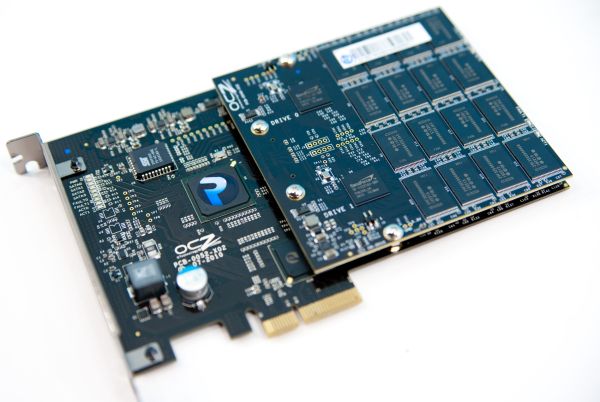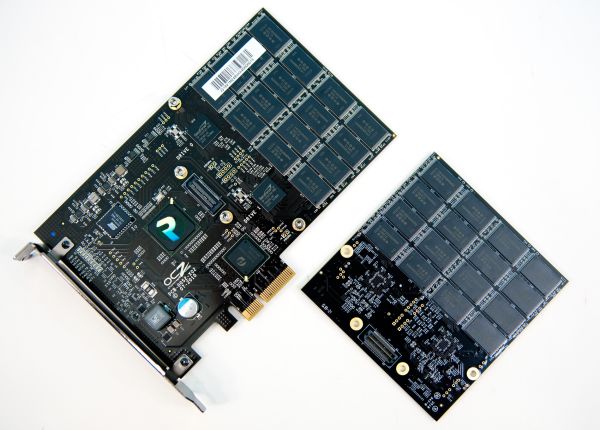A Quick Look at OCZ's RevoDrive x2: IBIS Performance without HSDL
by Anand Lal Shimpi on November 4, 2010 1:05 AM EST- Posted in
- Storage
- SSDs
- OCZ
- RevoDrive
- RevoDrive x2
A week after I previewed OCZ’s IBIS and the HSDL interface, SandForce revealed the specs of its next-generation enterprise SSD controller. The specs for the SF-2000 series call for up to 500MB/s sequential reads and writes, nearly saturating the newly introduced 6Gbps SATA bus. It should be no surprise that OCZ is very interested in moving away from SATA.
We met OCZ’s first PCIe based SSD two years ago with the Indilinx based zDrive. Take four Indilinx Barefoot controllers, RAID them together on a PCIe card and you’ve got a zDrive. The first SandForce based PCIe solution actually took a step backwards: the OCZ RevoDrive only used two SandForce SF-1200 controllers.
Performance was of course much better than the old zDrive. SandForce has all but put Indilinx out of our minds (and systems). But the recently announced IBIS and the suspicious unpopulated connector on the original RevoDrive made it clear that there was room for more performance.
Meet the RevoDrive x2:
Identical to the original RevoDrive in every way, the x2 adds a second PCB complete with two more SF-1200 controllers. With a total of four SF-1200s on board, running in RAID-0, you should get IBIS-like performance without the HSDL interface.
The architecture remains unchanged. To save on costs OCZ uses a PCI-X based RAID controller: the Silicon Image 3124. The 3124 has four independent SATA ports, each one connects to a SF-1200 controller.
Between the Sil3124 and the PCIe x4 interface is a Pericom PCI-X to PCIe bridge. It converts the parallel PCI-X signaling into serial PCIe. The Sil3124 can deliver 1GB/s of bandwidth to the Pericom bridge, as can the 4 PCIe lanes (1GB/s in each direction) so there are no interface bottlenecks here. A quartet of SF-1200 controllers can’t realistically push more than 1GB/s of data.
As with all RAID enabled solutions, there’s no TRIM support but you do get idle garbage collection.
There’s no performance advantage over you running four of your own SF-1200 based SSDs in RAID-0. The RevoDrive x2 is pretty much a four drive SF-1200 SSD on a stick for those who want simplicity.
The previous RevoDrive was supposed to be cost competitive with a two drive RAID array. Today, looking at pricing, a 240GB RevoDrive sells for $519 while a pair of 120GB Vertex 2s will set you back $480. You pay a premium for the simplicity but performance is identical to rolling your own SSD RAID setup.













46 Comments
View All Comments
me&er - Thursday, November 4, 2010 - link
Anand,I've Secure Erased both Revo x2 and IBIS a number of times using hdparm.
Infact, it's my preferred method with all SSD.
Here's the methodology:
http://www.ocztechnologyforum.com/forum/showthread...
Regards,
ezinner - Thursday, November 4, 2010 - link
Argh! Why do motherboard and peripheral manufacturer's take so long to release port upgrades? They churn out new processors and chipsets all the time, but lag behind on interconnecting high speed devices. I am so sick of the USB 2.0, serial and parallel ports still found many motherboards. Give me USB 3 and the new Intel optical interface. First you have to mass market them, then devices will come out that supprt them. Give us faster lanes. Music vendors are even worse. Keyboards still were using floppy drives and scsi ports during the last decade and use slower, lower capacity sd-ram.Kevin G - Thursday, November 4, 2010 - link
Chipsets are proprietary but high speed interconnects like SATA, USB ect. are industry standards which anyone can make devices for. Proprietary designs are easier to build as the designers know exactly the limited number of devices they interface with.The other issue with standards is that until chipsets include them, they'll incur an extra cost via an external chip for motherboard manufacturers. Thus even though the standard is complete and available, there will be some resistance for acceptance.
anon1234 - Thursday, November 4, 2010 - link
Does this card offer management of the RAID controller, i.e. can the RAID be turned off (JBOD mode)? There are a couple of scenarios where having 4 separate 'drives' is preferable to a single stripe set.Does TRIM still work if you do RAID/striping in software?
Spazweasel - Thursday, November 4, 2010 - link
Don't underestimate the value of ease-of-installation. That can add up pretty quickly to even a moderate sized organization. If it only takes a couple of minutes to install or swap a drive-on-a-card, versus drive-in-a-HD-format, you can make up the premium in price quickly.wojtek240 - Friday, November 5, 2010 - link
I somewhat liked the review but the ad and the review at the same time, its just a bit too much Ananad, credibility is still #1 for some folks.JarredWalton - Friday, November 5, 2010 - link
Advertisements are from a completely separate company, and they're basically "randomly" selected. I say randomly in quotes because I'm not even sure of all the details--some company could buy all of the storage ad space for a month if they were so inclined. I've read many a magazine where an ad appears opposite a review, and in some cases those are very negative reviews.Any good (and smart) company keeps editorial staff separate from the advertising, and AnandTech operates that way. I can say with 100% honesty that no one has ever asked me to deal with advertising, and that never once has anyone suggested I give a better review to a product because they're "a big advertiser." In fact, I know of a couple instances where companies have threatened to pull advertising because of negative (or at least not glowing) reviews, and Anand pretty much said see you later.
Other than that, I'm not sure what in this article would undermine credibility based on the ads anyway, as my impression is more of a, "yeah, it works, and it's like RAID-0 with four SSDs only you use a single PCIe slot. It carries a price premium as well, secure erase can be iffy, TRIM doesn't work so you have to depend on idle garbage collection, and we encountered a bug on SandForce when writing lots of uncompressable data". That's definitely not enough for me to want to jump at the Revo X2, especially considering the price.
adonn78 - Friday, November 5, 2010 - link
How much faster will it boot my PC over other SSD's or RAided drives? how long will it load a level of the 5 most popular games? Five us real world tangible statistics... IO's mean nothing to a gamer.krazyderek - Friday, November 5, 2010 - link
the OCZ vertex 2 120gb x 2 seems to be lacking QD32 benchmarks to compare it at the same performance metric, also shouldn't OCZ vertex 2 120gb x 4 also been included since that's the apples to apples comparison to a revo drive x2 in terms of controller count??And for that matter, why isn't the original revodrive shown for reference aswell?
i'm blown away by the revodrive x2 unfortunately that's cause there aren't any other numbers to compare it too...
AnnonymousCoward - Friday, November 5, 2010 - link
I couldn't find the PCIe gen in this article or the original RevoDrive one. Another site says it's PCIe 1. With all the talk about bandwidth, this is relevant. So PCIe 1 x4 = 1GB/s, and you used 804MB of that.Also, the charts are sort of hard to read with all the text and common colors; here's a way to improve it: http://i53.tinypic.com/3480bw4.png
Otherwise, good review. I think motherboards need to start including non-graphics multi-lane PCIe to accommodate high bandwidth drives.